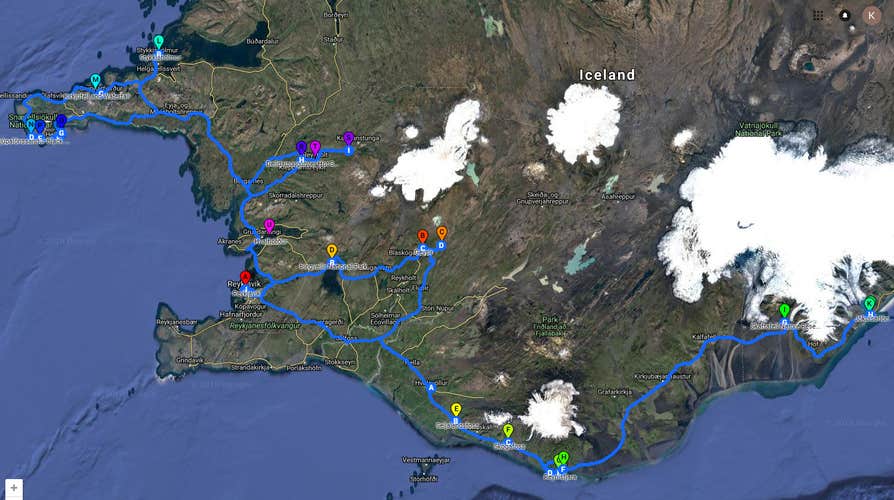คำอธิบาย
สรุป
คำอธิบาย
เพลิดเพลินกับทัวร์ที่หลากหลายสำหรับช่วงฤดูหนาว ที่คุณจะได้ล่าแสงเหนือตามสถานที่ที่สวยที่สุดในประเทศไอซ์แลนด์ เช่น อุทยานแห่งชาติธิงเวลลีย์ (Þingvellir) วัทนาโจกุล (Vatnajökull) และสไนล์แฟลซเนส (Snæfellsnes) ไม่เพียงเท่านั้น คุณจะยังได้ปีนไปยังธารน้ำแข็งที่งดงามของประเทศและสำรวจภายในของอีกหนึ่งการเดินทางชมถ้ำน้ำแข็งที่น่าประทับใจ
แพ็คเกจทัวร์ลดราคานี้เหมาะสำหรับนักท่องเที่ยวที่กำลังมองหาการที่จะได้ไปชมสถานที่ท่องเที่ยวไฮไลท์ของช่วงฤดูหนาวให้ได้มากที่สุดเท่าที่จะทำได้ และเหมาะสำหรับผู้ที่ต้องการที่จะมีส่วนร่วมในกิจกรรมที่น่าตื่นเต้นมากมาย เพลิดเพลินกับกิจกรรมทั้งหมดนี้โดยไม่ต้องวุ่นวายกับการขับรถหรือการจัดการแต่ละทัวร์
คุณจะได้เข้าร่วมกับสองทัวร์ที่แยกกันในการท่องเที่ยว 5 วัน ดังนั้นมั่นใจได้เลยว่าคุณจะได้ใช้เวลาอันมีค่าของคุณได้มากที่สุดในประเทศ หลังจากการได้เที่ยวชมเส้นทางวงกลมทองคำที่มีชื่อเสียงระดับโลกแล้ว คุณจะได้ออกไปสำรวจสถานที่ท่องเที่ยวที่น่ามหัศจรรย์มากมายตามเส้นทางชายฝั่งทางใต้ในช่วงเวลา 3 วัน
ในการเดินทางท่องเที่ยวครั้งนี้คุณจะได้เดินทางไปชมน้ำตกเซลยาแลนศ์ฟอสส์ (Seljalandsfoss) และน้ำตกสโกการ์ฟอสส์ (Skógafoss) ชายหาดทรายดำเรย์นิสฟยารา (Reynisfjara) และอัญมณียอดมงกุฏของประเทศไอซ์แลนด์ที่ชื่อว่า ทะเลสาบธารน้ำแข็งโจกุลซาลอน (Jökulsárlón) คุณจะได้ปีนธารน้ำแข็งโซลเฮมาร์โจกุล (Sólheimajökull) เพื่อที่จะได้ชมมุมมองแบบพาโนรามาที่น่าตื่นตาของพื้นที่บริเวณรอบๆ รวมทั้งยังได้เที่ยวชมถ้ำน้ำแข็งตามธรรมชาติภายในธารน้ำแข็งวัทนาโจกุล
ในแพ็คเกจทัวร์ส่วนที่สองคุณจะได้ออกเดินทางโดยรถมินิบัสไปยังคาบสมุทรสไนล์แฟลซเนสอันน่าทึ่ง ภูมิภาคที่มักถูกมองข้ามที่มีทั้งธารน้ำแข็งขนาดใหญ่และภูเขาไฟสไนล์เฟลส์โจกุล ระหว่างการเดินทางของคุณ คุณจะได้ชมน้ำตก ภูเขาไฟ ธารน้ำแข็งและน้ำพุร้อนพลังงานใต้พิภพจำนวนมาก รวมถึงแนวชายฝั่งที่งดงาม
ความงดงามตามธรรมชาติของคาบสมุทรสไนล์แฟลซเนสที่ไม่มีใครแตะต้องและไม่มีมลพิษทางแสง นั่นหมายถึงท้องฟ้าช่วงกลางคืนที่ปลอดโปร่ง คุณสามารถมองเห็นการแสดงบนท้องฟ้าของแสงเหนือได้ คุณจะจบทัวร์ของคุณด้วยการเดินทางกลับไปยังเมืองเรคยาวิก (Reykjavík)
ใช้ช่วงเวลาในช่วงฤดูหนาวของคุณในประเทศไอซ์แลนด์ให้คุ้มค่าและประหยัดด้วยแพ็คเกจนี้ ตรวจสอบความพร้อมของวันเดินทางที่ต้องการได้ทันทีเพียงเลือกวันที่


















